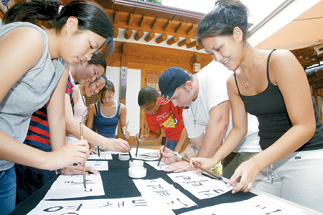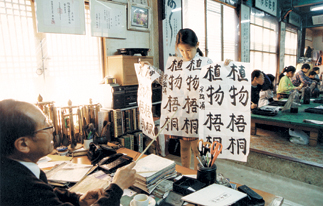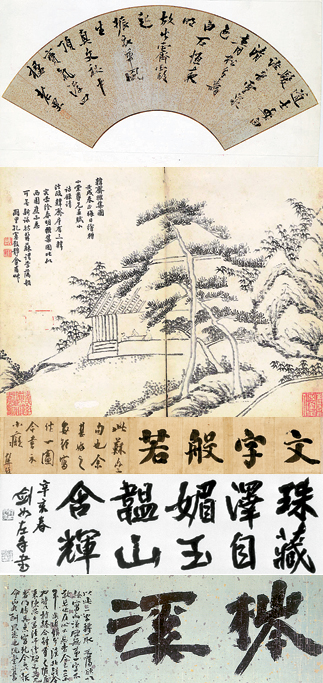Making lines that run from the heart


foreign exchange students at a local university practicing calligraphy as part of their program.
He wrote that the best form of writing “is not bound to form, and purely aims at experimentation.”
“In writing there is no need for a person to be bound to the old formulas,” he wrote. “It’s a good piece of writing if the way you’ve expressed your thoughts with your brush does not look awkward on the page. To reach a state of art, after all, depends on my hands. If writing reflects the way of our life today, it’s not always best to follow the rules of the past. It’s better to produce real writing that portrays our mind today than to mimic the fake writing of yesterday. If my mind is full of happiness maybe that’s good enough.”
Chusa, always the artist-scholar, established his own “Chusa style” of writing and pioneered the idea of conceptual calligraphy in the 19th century. He stressed the need to develop one’s character through writing, rather than mimicking the works of others, relying on the spirit of an artwork rather than its form.
Indeed, his concept of art was a direct challenge to the mainstream art schools of his time, which were strictly focused on passing the rules of tradition on to their pupils. Despite his reluctance to follow popular taste, his artistic style is still praised by critics, who describe it as transcendentally elegant with a noted sense of pictorial composition and forceful strokes.

a traditional school that teaches calligraphy to young students. [JoongAng Ilbo]
Some of Chusa’s work is currently on display at the Seoul Arts Center, in an exhibition entitled “All Rivers Flow to the Sea,” which commemorates the 150th anniversary of his death. The exhibition has created a renewed interest in calligraphy.
Seoye, the Korean word for calligraphy, means “the way of writing.” However, according to the dictionary definition, the concept of calligraphy is something more complex. It explains that “the essence of calligraphy is an expression of the writer’s mental state.”
Script produced by noted scholars and historians is more valued at auctions than the work of professional calligraphers, because it’s the life of the person, not the writing itself, that counts in calligraphy.
Indeed, the sprit of calligraphy that Chusa focused on is an aspect of the time-honored tradition of handwriting in Korea, where script is used as an important medium to gauge a person’s character. This idea was deeply embedded among the aristocrats of old Korea, who saw calligraphy as mandatory training to discipline a person’s mind.
A famous episode, that most Koreans hear about from their parents is the story of Han Seok-bong, a noted calligrapher and scholar from the Joseon dynasty, and his mother.
The story goes that Han’s mother, who raised her son alone in a poor home by selling rice cakes, turned out the lights one evening and told her son to write in the dark while she cut long pieces of rice cake. She wanted to test her son’s discipline.

All works by Chusa. [JoongAng Ilbo]
Even today, calligraphy is taught in many elementary schools as a mandatory part of the art curriculum. Calligraphers still write family slogans or compliments from friends that are framed and hung in family living rooms as a sign of dignity. When Koreans want to imply that somebody is very academic or has been well-educated, they say, sometimes with a hint of sarcasm, that the person has a “trace of ink” in their writing.
The tradition of Korean calligraphy is derived from similar techniques of literary painting that have been practiced in China and Japan, but calligraphy began without being clearly distinguished from painting.
The tradition of calligraphy in Korea dates back to the Three Kingdoms period, in which most work consisted of inscriptions on stone monuments. A particularly significant work is a stone monument built in A.D. 414, near southern Manchuria, to commemorate the military achievements of King Kwanggaeto of Goguryeo.
The excavation of the tomb of King Muryong and his queen in Gongju, the old capital for Baekjae, in 1972, led to many precious archaeological finds including several works of calligraphy engraved on stone slabs.
During the Unified Silla Kingdom the style of many works mimicked famous Chinese calligraphers such as Ou Yang-hsun and Yu Shin-nan. In Goryeo, handwriting was included as mandatory aspect of the civil service exam.
When Buddhism became the state religion, calligraphers had more opportunities to demonstrate their skills, writing on tombstones, woodblock prints and handwritten copies of Buddhist scriptures.
The Joseon dynasty, however, was the peak of calligraphy’s academic manifestation in all areas of art and philosophy. By the 19th century, specific styles began to emerge as an important element in calligraphy, although many critics point out that the styles from the period relied more heavily on the tastes of kings and the mainstream schools of the era, rather than unique individual expressions.
Lee Hwang was the dominant figure in calligraphy during the 16th century, although he was better known as a Confucian scholar; Jeong Yak-young was another leading philosopher who represented Silhak (the study of practical science) while working in calligraphy. A notable trait of the Joseon dynasty was that many of its kings also practiced calligraphy.
Overall, calligraphy is very similar to other forms of Korean art, in that they are formally simple, but conceptually complex. As an example, the practice of calligraphy is often compared to a well-choreographed dance in its coordination of movement. A work’s quality is assessed based on the ink’s tone, the vibrancy of its curves, the strength of composition and its artistic character, while each stroke is seen as a complex gesture that captures important aspects of the universe.
A new group of contemporary artists in Korea are now using calligraphy as a form of performance art. They see the momentary gesture of writing to be similar to the rhythms of performance art. Experts find echoes of calligraphy’s profound beauty in the minimal shapes of porcelain, in Korean costumes and wooden plates passed down from the Joseon dynasty.
The concept of calligraphy in that sense matches the teachings of Lao Tse ― one of the principle philosophers in East Asia ― who wrote that “once you find the way, it creates one, one creates two, two creates three, and three creates all things under the sun.”
By Park Soo-mee Staff Writer [myfeast@joongang.co.kr]










with the Korea JoongAng Daily
To write comments, please log in to one of the accounts.
Standards Board Policy (0/250자)